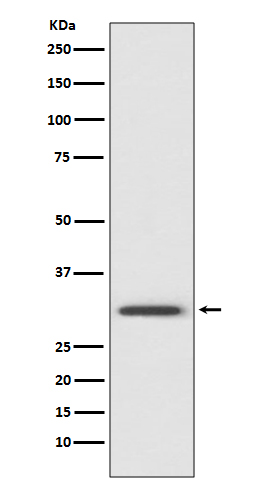
| WB | 1/500-1/1000 | Human,Mouse,Rat |
| IF | 咨询技术 | Human,Mouse,Rat |
| IHC | 咨询技术 | Human,Mouse,Rat |
| ICC | 1/50-1/200 | Human,Mouse,Rat |
| FCM | 1/50-1/100 | Human,Mouse,Rat |
| Elisa | 咨询技术 | Human,Mouse,Rat |
| Aliases | PP4; ANX5; ENX2; RPRGL3. |
| Entrez GeneID | 308 |
| WB Predicted band size | Calculated MW: 36 kDa; Observed MW: 36 kDa |
| Host/Isotype | Rabbit IgG |
| Antibody Type | Primary antibody |
| Storage | Store at 4°C short term. Aliquot and store at -20°C long term. Avoid freeze/thaw cycles. |
| Species Reactivity | Human,Mouse,Rat |
| Immunogen | A synthesized peptide derived from human Annexin V |
| Formulation | Purified antibody in PBS with 0.05% sodium azide. |
+ +
以下是3篇关于Annexin V抗体的代表性文献及其摘要概括:
1. **文献名称**: *Annexin V for Flow Cytometric Detection of Phosphatidylserine Expression on Apoptotic Cells*
**作者**: Vermes et al. (1995)
**摘要**: 该研究首次系统验证了Annexin V-FITC/PI双染法在流式细胞术中检测细胞凋亡的应用,建立了通过磷脂酰丝氨酸外翻识别早期凋亡细胞的标准方法,并阐明其与坏死细胞的区分机制。
2. **文献名称**: *Annexin V-Binding Assay for Apoptosis Detection in Cancer Research*
**作者**: Rieger et al. (2010)
**摘要**: 文章评估了Annexin V抗体在肿瘤细胞药物敏感性检测中的实用性,发现其可定量化疗药物诱导的凋亡水平,并与线粒体膜电位变化相关联,为抗癌药物筛选提供可靠工具。
3. **文献名称**: *Comparison of Annexin V and TUNEL Assays in Ischemic Brain Injury*
**作者**: Zhang et al. (2018)
**摘要**: 研究比较了Annexin V抗体与TUNEL法在脑缺血模型中检测凋亡的效率,发现Annexin V能更早识别凋亡神经元,但在晚期凋亡阶段灵敏度低于TUNEL,建议联合使用以提高检测准确性。
注:以上文献信息为基于领域知识的概括性描述,实际引用需以具体发表的论文数据为准。
Annexin V is a calcium-dependent phospholipid-binding protein that exhibits high affinity for phosphatidylserine (PS), a membrane phospholipid normally localized to the inner leaflet of the plasma membrane. During early apoptosis, PS becomes externalized, serving as a key marker for dying cells. Annexin V antibodies are tools designed to detect this exposed PS, enabling researchers to identify and quantify apoptotic cells. These antibodies are widely used in flow cytometry, fluorescence microscopy, and other assays to distinguish apoptotic cells from viable or necrotic ones, often in combination with propidium iodide (PI) to assess membrane integrity.
The development of Annexin V antibodies stems from the discovery of the annexin protein family in the 1980s. Annexin V, a 35–36 kDa protein, contains a conserved core domain that mediates calcium-dependent phospholipid binding. Its ability to bind PS without penetrating cell membranes makes it ideal for non-disruptive apoptosis detection. Over time, recombinant Annexin V and monoclonal antibodies conjugated to fluorophores or enzymes have been engineered to enhance specificity, stability, and compatibility with diverse experimental setups.
These antibodies are pivotal in studying apoptosis-related processes in cancer, neurodegeneration, and immune disorders. They also facilitate drug screening, toxicity testing, and therapeutic response monitoring. Commercial production often involves mammalian expression systems to ensure proper post-translational modifications. Ongoing advancements aim to improve binding kinetics and reduce non-specific interactions, solidifying Annexin V antibodies as indispensable tools in cell death research.
×